

Comparatif de 12 solutions de curation. Dans le cadre du dossier sur la curation que jai eu le plaisir de coordonner pour la revue Documentaliste et Sciences de linformation de mars 2012 ( ), jai eu loccasion de réaliser un comparatif de 12 solutions dont je vous propose ci-dessous quelques éléments complémentaires.
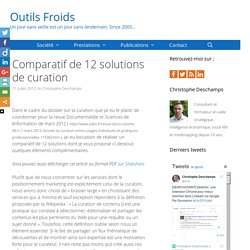
Vous pouvez aussi télécharger cet article au format PDF sur Slideshare Plutôt que de nous concentrer sur les services dont le positionnement marketing est explicitement celui de la curation, nous avons donc choisi de « brasser large » en choisissant des services qui, à minima et sauf exception répondent à la définition proposée par la Wikipedia : « La curation de contenu () est une pratique qui consiste à sélectionner, éditorialiser et partager les contenus les plus pertinents du Web pour une requête ou un sujet donné ».
Toutefois, cette définition oublie selon nous un élément essentiel. Les douze solutions sélectionnées. Comment ça marche ? Vous connaissiez le Sav, le service après-vente ?
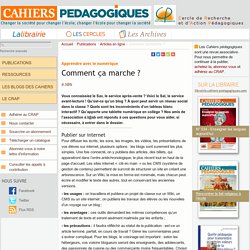
Voici le Sal, le service avant-lecture ! Qu’est-ce qu’un blog ? À quoi peut servir un réseau social dans la classe ? Quels sont les inconvénients d’un tableau blanc interactif ? Qu’apporte une tablette numérique en collège ? Publier sur internet Pour diffuser les écrits, les sons, les images, les vidéos, les présentations de vos élèves sur internet, plusieurs options : les blogs sont surement les plus simples. Traam_doc_toulouse_11-12. Why Curation Will Transform Education and Learning: 10 Key Reasons. There is a growing number of key trends that are both rapidly revolutionizing the world of education as we know it and opening up opportunities to review and upgrade the role and scope of many of its existing institutions, (as the likeliness that they are going to soon become obsolete and unsustainable, is right in front of anyone's eyes).
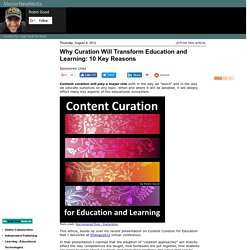
George Siemens, in his recent Open Letter to Canadian Universities, sums them up well: 1) An Overwhelming Abundance of Information Which Begs To Be OrganizedThe goal is not (and probably it never was) to learn or memorize all of the information available out there. It's just too much even if we focus only on the very essence of it. The goal is to learn how to learn, to know where to look for something and to be able to identify which parts of all the information available are most relevant to learn or achieve a certain goal or objective.This is why new digital literacy skills are of such great importance.
From the New York Times: "...Mr. PROPOSITION D’UNE GRILLE DESCRIPTIVE DE SCENARIO PEDAGOGIQUE. Content Curation for Teachers. Have you ever felt that there is simply too much interesting, educational content on the web? Fortunately, there are also some great, free products that help learners curate all of the many things they can read, watch, hear etc. on the web. The beauty of taking control of your content by saving and organizing links is that you can quickly find, revisit or share content with others. By curating the web, one can essentially build up a library of data in the cloud for free. I know personally as a history teacher, I spend a lot of time surfing the web when I prepare lessons.
In addition, through my own exploration of the web and thanks in large part due to services like Twitter, Google Plus, Stumble Upon, and YouTube, I come across things that I want to teach my students in the future. The content curation tools that I have found most useful are Pearltrees, Diigo and Evernote. 1. 2. 3. Personal Use: Evernote is a slightly different service than the previously noted applications. Pearltrees for teachers. Year 2012 last post is a guest post from Finnish teacher Tommi Viljakainen.
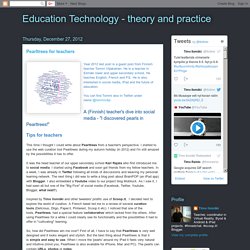
He is a teacher in Elimäki lower and upper secondary school. He teaches English, French and P.E. He is also interested in social media, iPad and the future of education. You can find Tommi also in Twitter under name @tommiviljaA (Finnish) teacher's dive into social media - "I discovered pearls in Pearltrees! " Technologie - pearltrees : organiser des parcours sur le web. Pearltrees: création de documents virtuels « CIEL. Utilisation de Pearltrees à l'école. Dossier réalisé par le CLEMI de l’Académie de Versailles et publié sur Educnet.
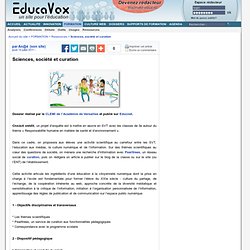
Chaque année, un projet d’enquête est à mettre en œuvre en SVT avec les classes de 3e autour du thème « Responsabilité humaine en matière de santé et d’environnement ». Dans ce cadre, on proposera aux élèves une activité scientifique au carrefour entre les SVT, l’éducation aux médias, la culture numérique et de l’information. Sur des thèmes scientifiques au cœur des questions de société, on mènera une recherche d’information avec Pearltrees, un réseau social de curation, puis on rédigera un article à publier sur le blog de la classe ou sur le site (ou l’ENT) de l’établissement. 1 - Objectifs disciplinaires et transversaux.